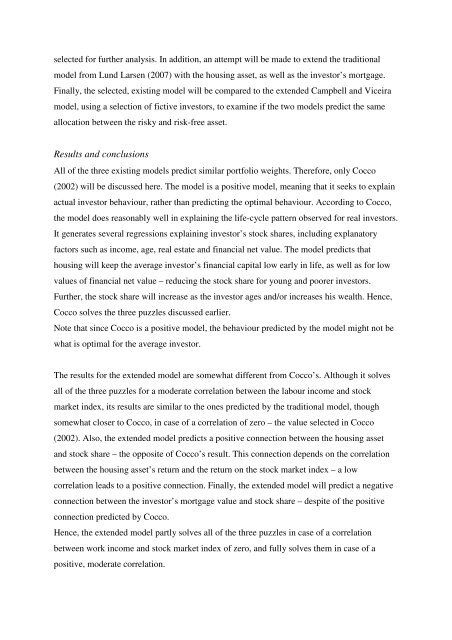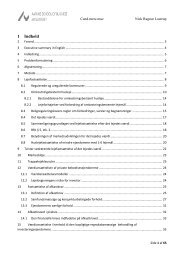Den langsigtede investors optimale porteføljevalg med ... - DN Erhverv
Den langsigtede investors optimale porteføljevalg med ... - DN Erhverv
Den langsigtede investors optimale porteføljevalg med ... - DN Erhverv
Create successful ePaper yourself
Turn your PDF publications into a flip-book with our unique Google optimized e-Paper software.
selected for further analysis. In addition, an attempt will be made to extend the traditional<br />
model from Lund Larsen (2007) with the housing asset, as well as the investor’s mortgage.<br />
Finally, the selected, existing model will be compared to the extended Campbell and Viceira<br />
model, using a selection of fictive <strong>investors</strong>, to examine if the two models predict the same<br />
allocation between the risky and risk-free asset.<br />
Results and conclusions<br />
All of the three existing models predict similar portfolio weights. Therefore, only Cocco<br />
(2002) will be discussed here. The model is a positive model, meaning that it seeks to explain<br />
actual investor behaviour, rather than predicting the optimal behaviour. According to Cocco,<br />
the model does reasonably well in explaining the life-cycle pattern observed for real <strong>investors</strong>.<br />
It generates several regressions explaining investor’s stock shares, including explanatory<br />
factors such as income, age, real estate and financial net value. The model predicts that<br />
housing will keep the average investor’s financial capital low early in life, as well as for low<br />
values of financial net value – reducing the stock share for young and poorer <strong>investors</strong>.<br />
Further, the stock share will increase as the investor ages and/or increases his wealth. Hence,<br />
Cocco solves the three puzzles discussed earlier.<br />
Note that since Cocco is a positive model, the behaviour predicted by the model might not be<br />
what is optimal for the average investor.<br />
The results for the extended model are somewhat different from Cocco’s. Although it solves<br />
all of the three puzzles for a moderate correlation between the labour income and stock<br />
market index, its results are similar to the ones predicted by the traditional model, though<br />
somewhat closer to Cocco, in case of a correlation of zero – the value selected in Cocco<br />
(2002). Also, the extended model predicts a positive connection between the housing asset<br />
and stock share – the opposite of Cocco’s result. This connection depends on the correlation<br />
between the housing asset’s return and the return on the stock market index – a low<br />
correlation leads to a positive connection. Finally, the extended model will predict a negative<br />
connection between the investor’s mortgage value and stock share – despite of the positive<br />
connection predicted by Cocco.<br />
Hence, the extended model partly solves all of the three puzzles in case of a correlation<br />
between work income and stock market index of zero, and fully solves them in case of a<br />
positive, moderate correlation.




